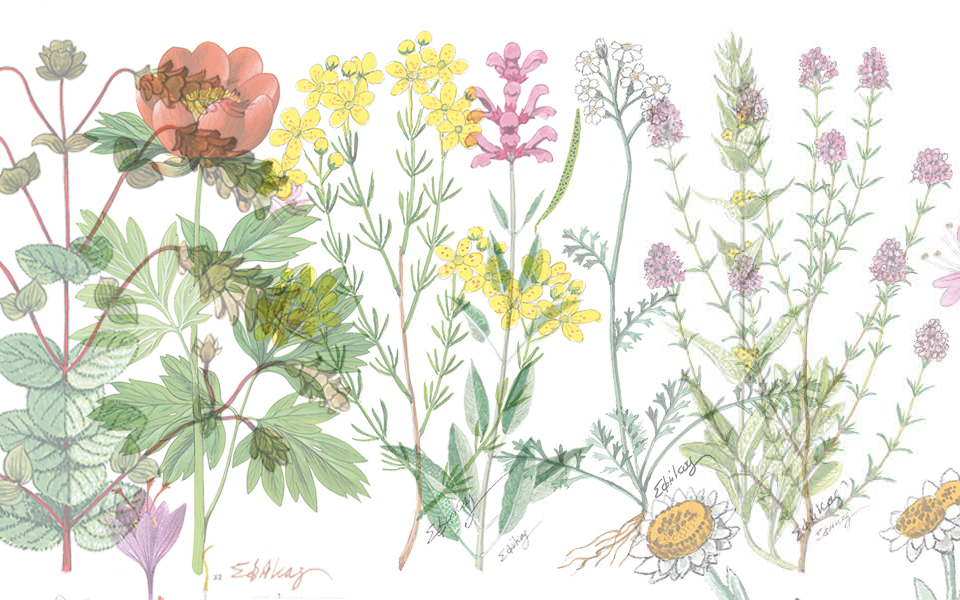A wander around any of nature’s gardens in Greece is a journey back to a land of legend and symbolism, a magical place where men are heroes and where gods give shape to every plant. This is where nymphs elude their pursuers by transforming themselves into fragrant shrubs and where god-sent herbs bring us comfort and succor in abundance.
Greece’s natural environment is known for its diverse landscape and myriad microclimates; this variety creates ideal conditions under which certain herbs and medicinal plants can thrive. Dwarf oregano, thyme from the Aegean archipelago, Greek sage and dozens of other herbs that grow here are all endowed with aromatic qualities and medicinal properties more powerful than those found in other countries. What’s more, Greece’s wild plants seem quite happy to flourish in the rugged mountain fields which far outnumber lush irrigated farms.
At the same time, we must not overlook the important presence of Greece’s endemic plants, those that can only be found within the country’s borders, many of which have exceptional qualities. Some of these constitute remnants of older geological periods, though most appeared more recently as a result of the particular conditions prevailing in a part of the world where three continents converge. Intense phenomena such as the birth of new islands and mountain ranges, sinkholes and volcanic eruptions have reshaped the landscape again and again through the eons, forcing some species into isolation. Naturally, only a handful of these have survived and can still be found in the wild; they are nature’s acrobats, successful experiments of evolution, because they managed to adapt to and survive the harshest of conditions.
The parts of Greece considered “hot houses” of endemic plants are Central Greece, the Peloponnese and the islands of the Aegean, including Crete. To put it in numbers, of the 6,500 species and subspecies that constitute Greek flora, some 1,300, or one in five, are endemic. Imagine that Crete alone has 165 native plants when Germany – roughly 45 times the size of the Greek island – has just 42. The bad news is that 25 percent of Greek endemic plants are considered endangered or at risk of extinction. Those that appear only in a restricted geographical area in particular are at risk from factors as mundane as the opening of a new mountain road, the installation of a wind farm, forest fires, prevalent over-grazing and the aggressive development of our coastlines.
“For every plant that survives the process of being uprooted and transplanted, several dozen are destroyed, thus putting the survival of the species under even more strain.”
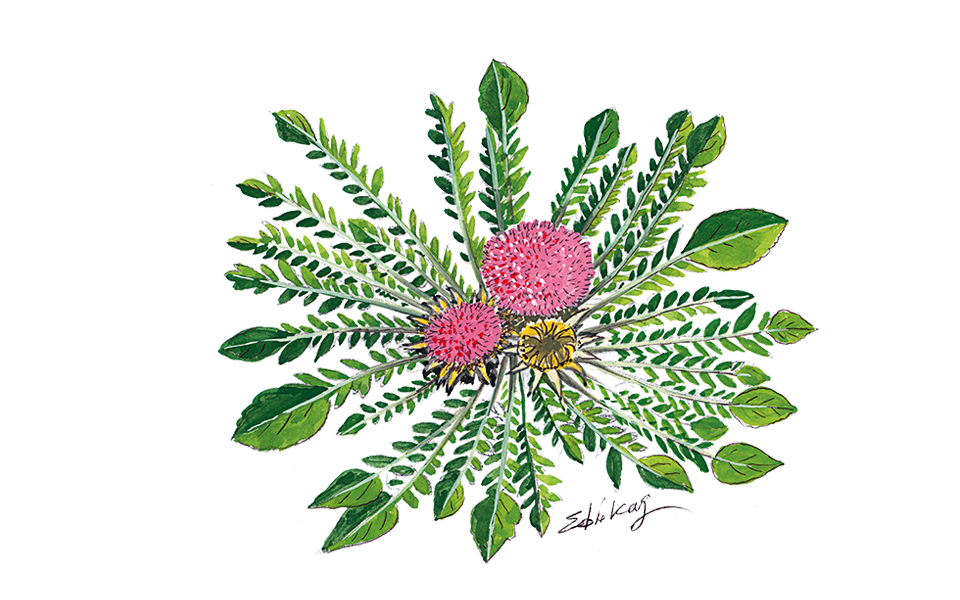
“The intense, heady aroma of freshly-cut mountain tea is said to evoke a sense of euphoria, and I observed this firsthand in my fellow collectors’ broad smiles…”
Another foe that has been around for at least three centuries now is the collector: sundry botanists, nature lovers and hunters of rare plants are scouring the Greek countryside in search of treasures to complete their collections. This means that visitors to botanical gardens across Europe can admire some 300 native Greek plants, while about 100 are even available for purchase abroad. But for every plant that survives the process of being uprooted and transplanted to foreign lands, several dozen are destroyed, thus putting the survival of the species under even more strain. The last of these plants find shelter in remote, inaccessible parts of the country, often high up on its mountains. It is estimated, in fact, that one-third of the country’s native species live at an altitude of over 1,000 meters.
Measures are desperately needed to ensure the survival of Greece’s endemic plants, as we have seen time and again that domestic legislation and international agreements have little if any effect. Efforts should initially focus on highlighting their importance and then on utilizing them to their best possible advantage, in cooperation, of course, with local communities. I am certain that, of the millions of visitors who come to Greece every year, many would be happy to go on nature walks acquainting them with the rare and native plants of each region.
I have no objection to ongoing efforts to ensure their survival through seed banks, though to date these efforts can be described, at best, as being rather lackluster. The most promising way forward, however, is for these plants – or at least those which could be used in cosmetic and pharmaceutical products or as edible or ornamental plants – to be cultivated organically at protected farms near their natural habitat. A significant part of the proceeds from their sale could then go towards protecting the wild population so that it can continue to act as a living treasury of their valuable genetic secrets.
ABOUT THE ATHOUR
Orestes Davias is a biologist and writer.
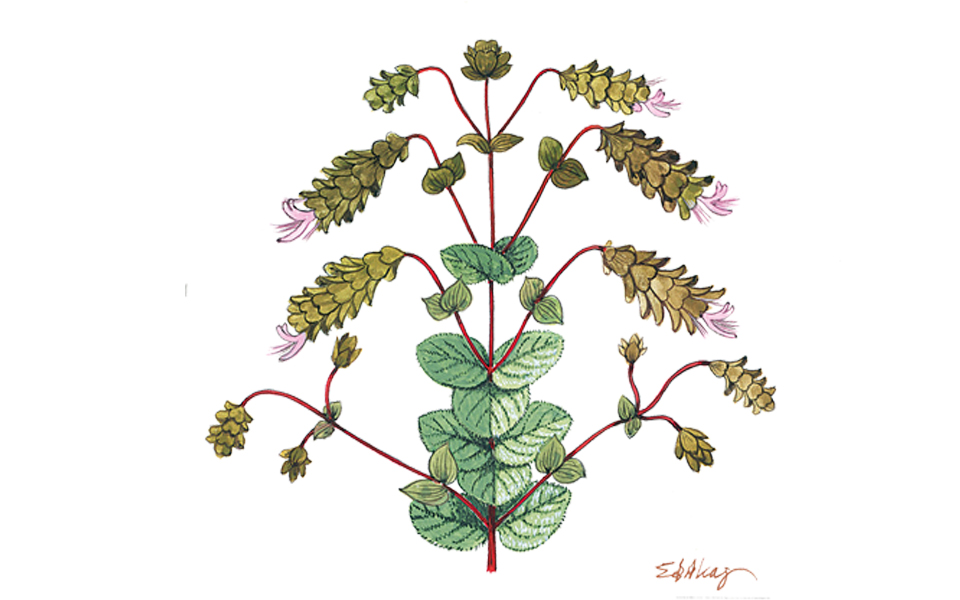
10 EXCEPTIONAL ENDEMIC SPECIES
CRETAN DITTANY
ORIGANUM DICTAMNUS
Since ancient times, Cretan dittany has been the absolute panacea of folk healing on the southern Aegean island. Its reputation was greatly helped by a reference by Aristotle suggesting that when wild goats were hit by poison-tipped hunting arrows, the animals would eat dittany to counteract the venom and heal the wound. In its wild form, this low-lying bush is found in rugged craggy terrain, but it is also cultivated in the valley of Embaros near Irakleio, which has taken some of the pressure generated by its traditional collectors off wild dittany.
The Cretans drink dittany as a tisane to ward off colds and headaches, to ease rheumatic and stomach pain, and as a general tonic. In older times, it was also used in poultices to heal wounds, chewed to soothe toothache and swollen gums, and added to baths to preserve youth and increase virility.
A plethora of scientific studies have attributed its efficacy in these uses to antibacterial, expectorant, astringent and antispasmodic properties. Studies are still being conducted into its potential but it is certain that Cretan dittany’s age-old reputation will survive for centuries to come.
GREEK KNAPWEED
CENTAUREA RAPHANINA SUBSP. MIXTA
That this endemic Greek plant has more names in the Greek language than any other is indicative of the huge culinary interest it engenders in the Peloponnese, Central Greece and many Aegean islands. Fortunately, it is extremely adaptable and grows at high altitudes, on rocky slopes, in olive groves and brush land, so that there is still plenty to be found, despite intensive harvesting. It stands out for its rosettes of dark-green and deeply lobed leaves and particularly for the purple blooms that emerge in later spring on a short stem.
Its leaves are gathered when they’re still sweet and tender, and they are eaten boiled, sautéed or even pickled, as a delightful meze to go with ouzo. However, it also has many promising pharmaceutical properties (both fungicidal and antioxidant), making it very likely that it will soon be cultivated systematically for its extracts.
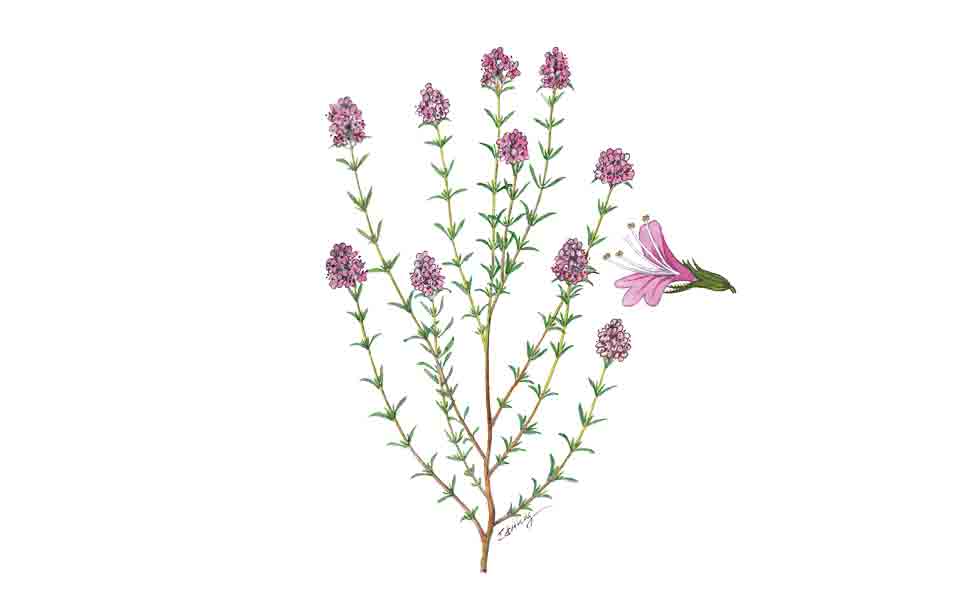
LACONIAN THYME
THYMUS LACONICUS
Its similarity to the prolific conehead thyme (Coridothymus capitatus) that is found all over southern Greece and its own rarity have kept this species practically unknown until recently. However, if you know what you’re looking for, it can be found in the fallow fields and rocky shrub land of the southeastern tip of the Peloponnese at Cape Maleas. It prefers areas that are cooled by the sea breeze, though it also has a remarkable tolerance for drought, and can be found at altitudes of up to 900 meters.
It has multiple branches, a woody stem and an incredible heady aroma, which explains the frenzy of bees seeking the nectar of its rosy blooms at the start of summer. There have been no comprehensive studies of this plant so far, but this is certainly about to change, as there is little doubt that it has significant antimicrobial and expectorant properties as well as digestive uses.
This, combined with the fact that it is rare yet grows with relative ease, suggests that Laconian thyme has a bright commercial future.
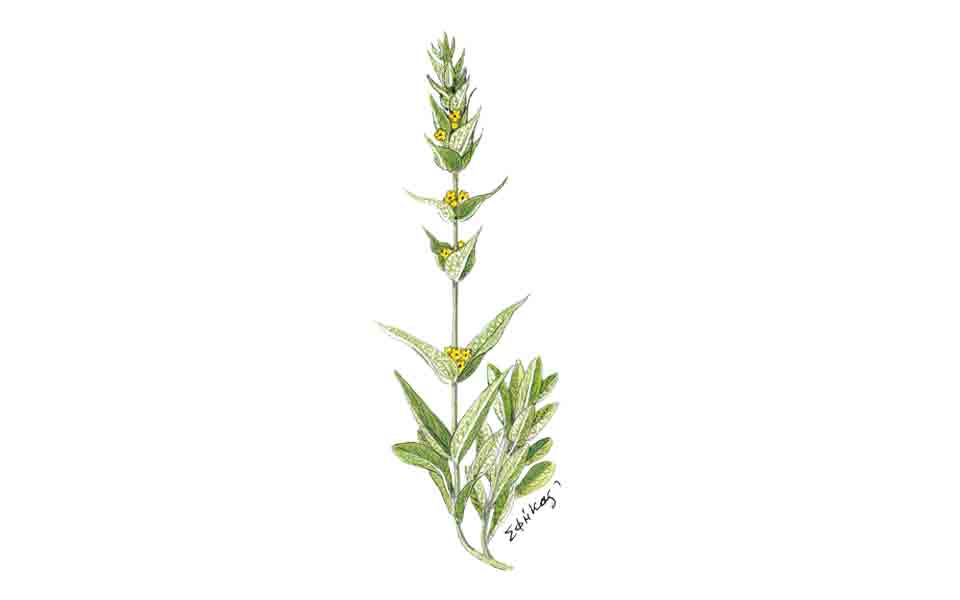
TAYGETUS MOUNTAIN TEA
SIDERITIS CLANDESTINA SUBSP. CLANDESTINA
This is one of seven endemic species of the Sideritis genus – also known as ironwort or shepherd’s tea – that is native to the rocky terrain of Greece’s mountains. I had the good fortune to observe a magical harvest just last June. The collectors’ scythes became a blur of slashing blades as soon as we arrived at the spot, and our bounty soon piled up. The intense, heady aroma of freshly-cut mountain tea is said to evoke a sense of euphoria, and I observed this firsthand in my fellow collectors’ broad smiles and in the wild bees diving deep into the yellow blossoms to suck up their stimulating nectar.
However, decades of unregulated harvesting in combination with over-grazing have placed this particular subspecies and the genus in general at risk. There are a lot of reasons to introduce controlled cultivation, especially now as the international community is becoming aware of the great potential of Greek mountain tea. Scientists have proven that its infusion acts as a tonic without causing restlessness, helps digestion, softens a cough and does marvelous things against colds. It also has a bright future ahead in the food and cosmetics industries, as its extract has anti-inflammatory, antioxidant and antimicrobial properties.
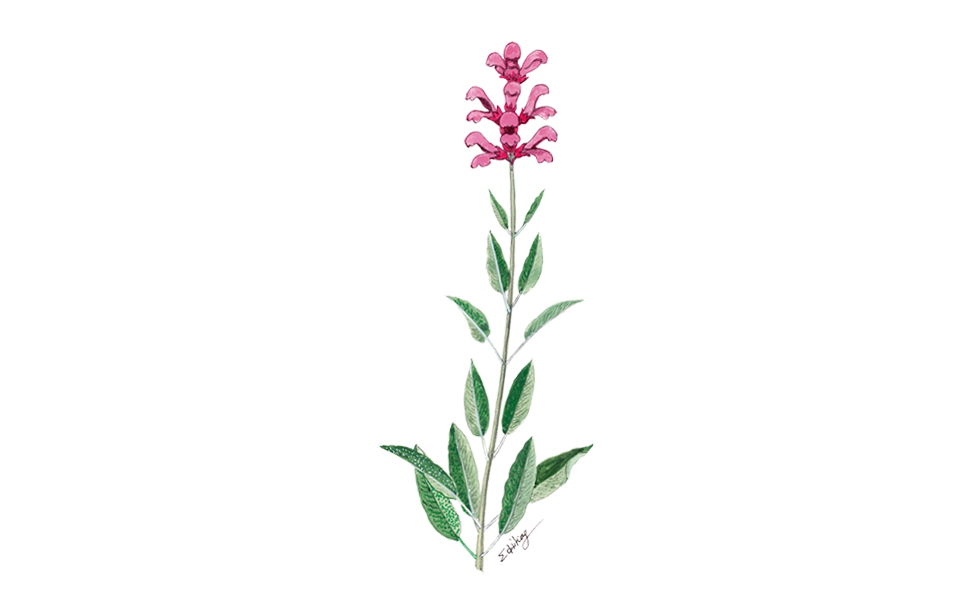
APPLE-BEARING SAGE
SALVIA POMIFERA SUBSP. POMIFERA
This species of wild sage that is endemic to southern Greece is not cultivated yet, but it is collected from the pine forests and rocky mountainsides where it thrives, often in large numbers. It is a low-lying bush that does not exceed one meter in height, and stands out among several native Greek sage species for its beautiful and relatively large red-blue spring blooms.
Its hairy leaves give off a strong and pleasant fragrance, and just a few are needed to prepare a delightful beverage that acts as a tonic and aids digestion, while also helping combat the effects of a cold.
It has quite a high concentration of essential oils, which are further activated during the warmer summer months. Even though this species has not been adequately studied, we do know that it has antiseptic, anti-inflammatory, antispasmodic and antiperspirant qualities.
The essential oils are said to boost concentration when inhaled and to relieve headaches and swollen gums when applied locally. Apple-bearing sage is also very promising as an additive in cosmetics, as it helps cleanse oily skin and prevent acne.
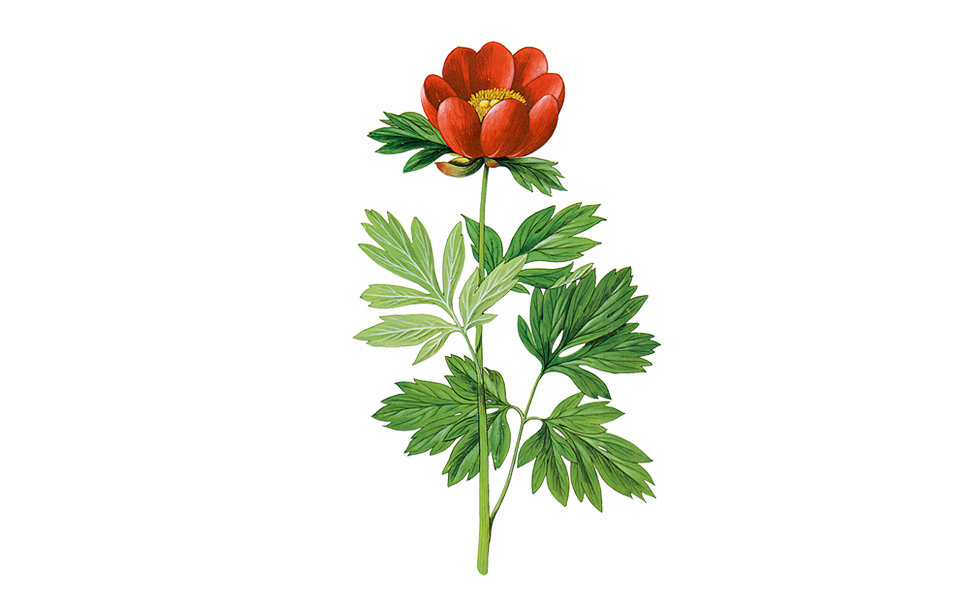
GREEK PEONY
PAEONIA PARNASSICA
With large, dark-purple petals that come out in May, this native plant gives us one of Greece’s most beautiful flowers. It is a relatively small plant (usually no taller than 70cm) that is endemic to Mount Parnassus and nearby Mount Helicon.
It is found in the clearings of conifer forests, in humid meadows and in ravines, usually tucked away between rocks, and at altitudes of up to 1,500 meters. It grows in small populations and is considered vulnerable because it is collected intensively for its decorative attributes, despite European Union regulations for its protection.
The genus Paeonia is named after Paean, a healer of the ancient gods who, according to legend, first discovered the powers of these plants. From Hippocrates to Galen, ancient physicians had no doubt that its roots and seeds cure spasms, nightmares, epilepsy and numerous female ailments.
The ancients actually thought it a magical plant and would collect it according to a ritual that ensured it would not be harmful. Modern science has so far discovered that its roots have useful antimicrobial properties, but it is certain that it will reveal many more secrets in the future.

MOUNT JUKTAS ST JOHN’S WORT
HYPERICUM JOVIS
Only found on the cliffs and crags of the mountains of Central Crete, this plant grows at altitudes ranging from 500-1,500 meters and only in rocky, calcareous soil; as such, it is extremely difficult to cultivate in different territories. It has tiny leaves speckled with numerous glands that look like dark spots, and produces bright yellow blooms in the spring. It is not endangered, as it is not collected locally, but it is considered vulnerable.
The plant belongs to the same genus as Hypericum perforatum – renowned mainly for healing wounds and acting as an antidepressant – while its epithet, jovis, is derived from Jupiter, after the ancient Roman name for the king of the Olympian gods. The reason it was given this epithet was that the Cretan believe Zeus’s tomb to be on one of the mountains on which it grows, Juktas.
In ancient Crete, the gods died and were reborn in spring. It is a funny coincidence, therefore, that the isolation of two new derivatives – hyperjovinols A and B – found from the plant demonstrated powerful antioxidant and anti-aging properties, which will almost certainly attract the interest of the pharmaceutical and cosmetics industries in the future.
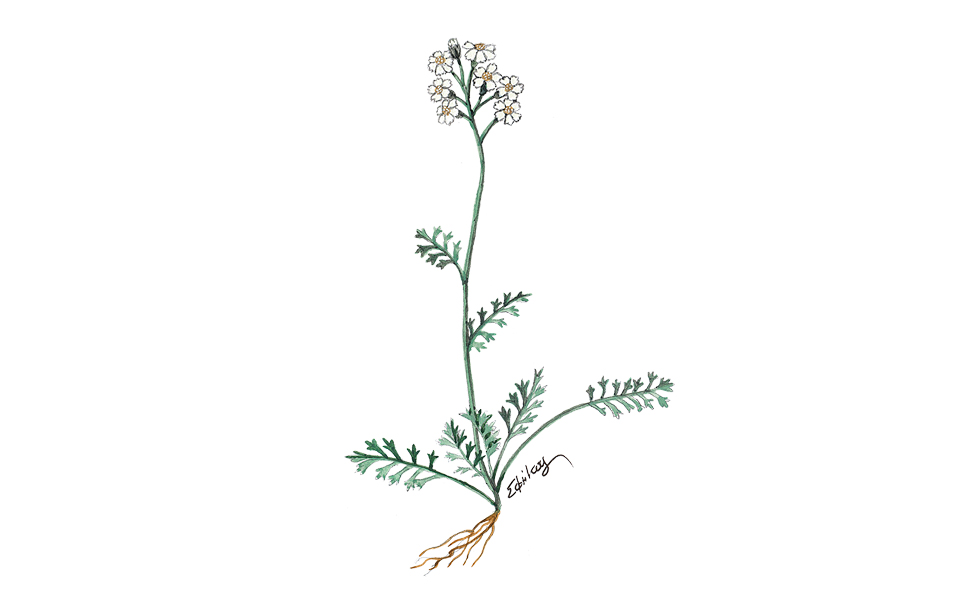
OLYMPUS YARROW
ACHILLEA AMBROSIACA
This is a small plant found only on the ancient world’s holiest mountain, Olympus. It grows from the mountain peak where Zeus launched his fearsome thunderbolts – at an altitude of 2,900 meters – down the rocky slopes, across the alpine meadows and along rocky crags, and only rarely at altitudes below 2,000 meters. Collecting its fragrant feathery leaves and the snow-white flower clusters that emerge in the summer is strictly forbidden, as the area is protected.
This also means that it cannot be cultivated in the area either, while at lower altitudes, the plant is vulnerable to diseases. Nevertheless, its unusual fragrance, the usefulness it almost certainly has in the production of cosmetics and its association with the mountain of the gods – a great marketing attribute – dictate measures to overcome these obstacles. With coordinated efforts in the laboratory and out in the field, it is certain that the day is not too far away when, thanks to its anti-aging effect on skin, this plant justifies its specific epithet (ambrosia being the food of the immortal gods).
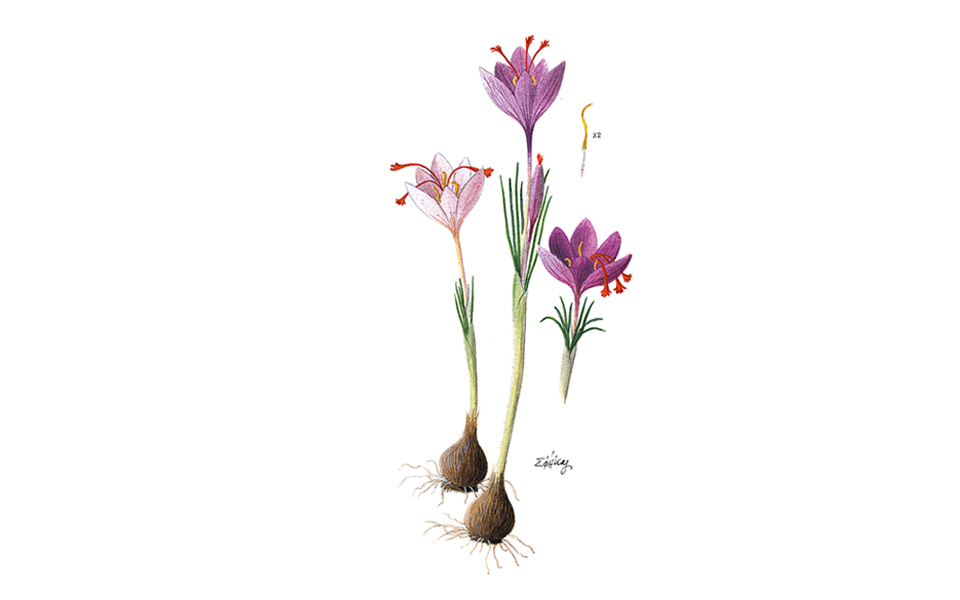
WILD SAFFRON CROCUS
CROCUS CARTWRIGHTIANUS
One of the splendid frescoes found in the prehistoric settlement of Akrotiri in Santorini (and dating from around the mid-second millennium BC) depicts two women in colorful robes filling their baskets with wild crocuses growing in abundance in a rocky landscape. Even today, the women of Santorini continue to collect the bloom every November, bending down again and again to snip out every gram of pure saffron. This arduous work is followed by the equally challenging task of separating the stigmas and stamens from the blooms, then drying and storing them so they can be used a few months later to add color and fragrance to traditional Easter cookies. Some locals claim that Santorini’s wild saffron has stimulative and aphrodisiac properties, echoing the views of ancient Greek healers.
This bloom – the progenitor of the more familiar domesticated species cultivated in different parts of the world – still grows wild in parts of the Cycladic islands, western Crete and Attica. Like the tame species, it has antioxidant, expectorant, anti-inflammatory and anticoagulant properties, just to name a few of its characteristics, so maybe it is time to “rediscover” this wonderful plant and give it back some of its ancient glory.
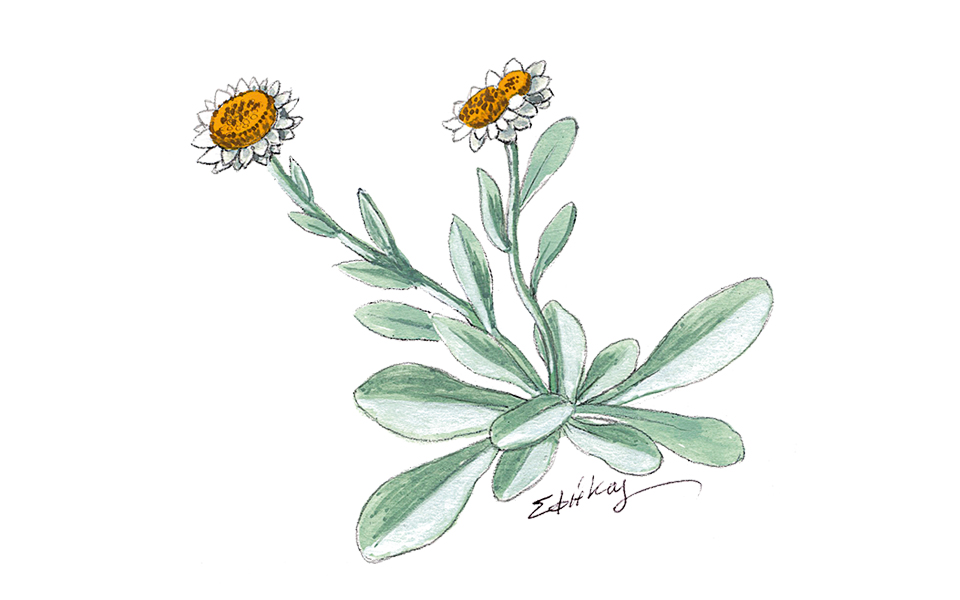
MOUNT ATHOS IMMORTELLE
HELICHRYSUM SIBTHORPII
Despite strict regulations banning its collection and its own ability to hide at altitudes of 2,000 meters in inaccessible crags on sacred Mt Athos in northern Greece, this rare species of immortelle could, until a few years ago, be purchased in pots online. Any plant at risk of extinction inevitably stirs the interest of collectors hunting down rare floral treasures. Part of this plant’s popularity, and one of the reasons why it struggles to survive, is its impressive appearance when in bloom during the summer months; it exemplifies alpine beauty.
When carefully dried, the plant keeps for a long time and maintains its delicate fragrance, a trait that reminds us of all the wonderful properties and rare powers contained in its blooms. Judging by close relatives of the same genus, we can surmise that its exceptionally fragrant essential oils are beneficial to the skin, and particularly older skin, protecting and healing it from the ravages of time. It seems a good idea to cultivate this wonderful shrub near its native lands, not only to ensure its survival but also to tap into its rejuvenating powers.

